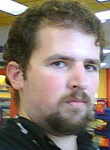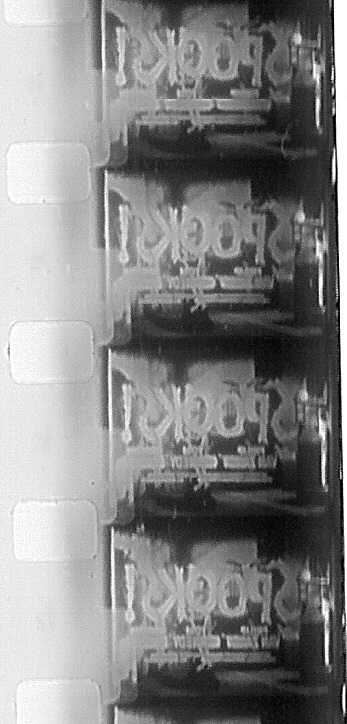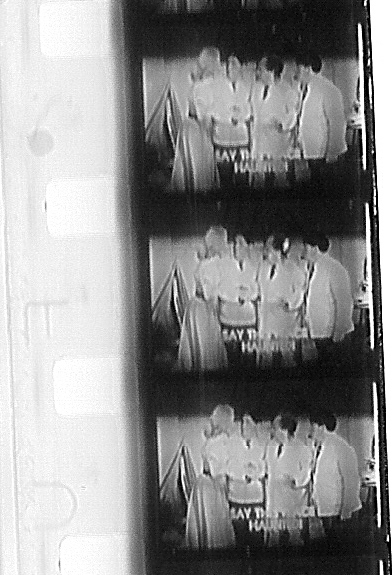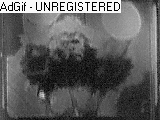|
|
 
|
|
Author
|
Topic: Backwards title on 8mm print, weird
|
|
|
|
|
|
|
|
|
|
|
|
|
Stephen Furley
Film God

Posts: 3059
From: Coulsdon, Croydon, England
Registered: May 2002
|
 posted 01-04-2007 05:54 AM
posted 01-04-2007 05:54 AM




Is this a sound film, the original, not the 8mm print? If so, then it's unlikely that the original 35mm element would have been flipped. This print looks like it's probably gone through quite a few generations; it's possible that the 8mm (come back to that in a moment) printing negative was reduction printed from a 16mm double perf element, in which case it could have been flipped.
Standard 8mm prints were made in several formats; the most common, at least in more recent times was two up on 16mm in 1-4 format; that is like the standard 8 camera format, there the two rows of perfs run down the outer edges of the 16mm strip, and the two rows of pictures run in opposite directions before slitting. Part of a printing neg in this format could not be flipped because the picture on each side would be different.
An alternative was the 1-3 format, where both rows of pictures ran in the same direction. In this format the two pictures next to each other would be the same, but again the printing neg couldn't be flipped, becauce one row of perfs is down the edge, but the other is just to one side of the centre of the strip. This format was used more for Super-8 printing, but I have seen a standard 8 example.
A third format printed three up on 35mm film, with standard 35mm perfs, and also three rows of 8mm perfs; the 35mm perfs were used for printing, and the 8mm ones were only in the print stock. A very similar system was used for three up on 35mm 9.5mm prints. I think the three 8mm prints were centered on the 35mm stock, with an equal amount of waste to be slit off on either side, in which case a printing neg in this format could be flipped.
Super-8 prints were normally two up on 16mm in 1-3 or 1-4 format or four up on 35mm with five rows of perfs, four normal Super-8 ones, and one slightly larger set on the 3mm waste strip. I can't remember the designation of this format; it was 35-32 something.
Technicolor also briefly printed Super-8 by dye transfer; these prints were three up as normal 35mm perfs were needed to register the stock on the pin belt.
Some small gauge prints are of very high quality, e.g. the Derann Super-8 prints of some of the Disney films, annd some of the early 9.5mm prints. In terms of 'quality per square mm', if there can be such a thing, they are equal to the best 35mm prints (no, I didn't say that 8mm was equal in quality to 35mm). The print runs are small, and they tend to be made on low speed printers. To be honest, your print doesn't look like a very high quality one. In the past 8mm printing negs have been made from all sorts of elements, including old 16mm library prints. My best guess is that this may be what happened in this case; the printing neg was made from a 16mm mute double perf print, which was flipped at a splice. If the print had been lacquered then it may not have been obvious which was the emulsion side. The quality control wasn't up to much, but we don't know anything about the history of this print. For example, it's possible that somebody who worked at a small lab, there were plenty of them in the past, borrowed a print from somewhere and ran off a pirate neg, and a few prints in a hurry, after hours when nobody was looking, and didn't notice the problem until it was too late.
| IP: Logged
|
|
|
|
Stephen Furley
Film God

Posts: 3059
From: Coulsdon, Croydon, England
Registered: May 2002
|
 posted 01-05-2007 03:42 PM
posted 01-05-2007 03:42 PM




Well, if it's of known origin, then that seems to rule out my theory that it might have been a pirate print, but in that case it seems odd that the fault wasn't found, and corrected.
I still think it's more likely that it was not the printing negative, but rather a previous element which was flipped, for the reason that I gave before.
Can we rule out the possibility that the title is intended to be flipped for some reason; I've never seen the film, so I don't know how it's supposed to look?
A couple of other points about 8mm prints that may be of interest; until sometime around 1999 I think it was, LGP Cine and Perry's Movies shared a shop in Raynes Lane, London. Ian, of Perry's had a small lab in the basement of the shop, where he printed mainly Super-8, in both 1-3 and 1-4 formats, but until the shop closed he was still printing a small amount of standard 8 black and white in 1-4 format, so that format lasted longer than most people would probably guess.
Larry of LGP bought up various items from the sale of Walton Films, when that company closed down. Among them were a large number of copies of a 50' version of Chaplin's 'The Cure'. Larry produced a booklet about Walon films, and sold it in a pach which included a copy of 'The Cure', and a few frames of many of the multiple 8mm and 9.5mm formats I described earlier, plus a few others. He was still selling them the last time I saw him, at the BFCC (British Film Collectors Convention) at Ealing Town Hall a couple of years ago.
The Super-8 prints sold by Derann Film Services are printed for them in 1-3 format, this format, or the four up on 35mm one are easier to use for magnetic striped prints, as all the prints run in the same direction, which makes the sound recording on them easier (the prints are striped and recorded while still in their multiple form, before slitting).
| IP: Logged
|
|
|
|
|
|
All times are Central (GMT -6:00)
|
|
Powered by Infopop Corporation
UBB.classicTM
6.3.1.2
The Film-Tech Forums are designed for various members related to the cinema industry to express their opinions, viewpoints and testimonials on various products, services and events based upon speculation, personal knowledge and factual information through use, therefore all views represented here allow no liability upon the publishers of this web site and the owners of said views assume no liability for any ill will resulting from these postings. The posts made here are for educational as well as entertainment purposes and as such anyone viewing this portion of the website must accept these views as statements of the author of that opinion
and agrees to release the authors from any and all liability.
|

 Home
Home
 Products
Products
 Store
Store
 Forum
Forum
 Warehouse
Warehouse
 Contact Us
Contact Us




 Printer-friendly view of this topic
Printer-friendly view of this topic

















